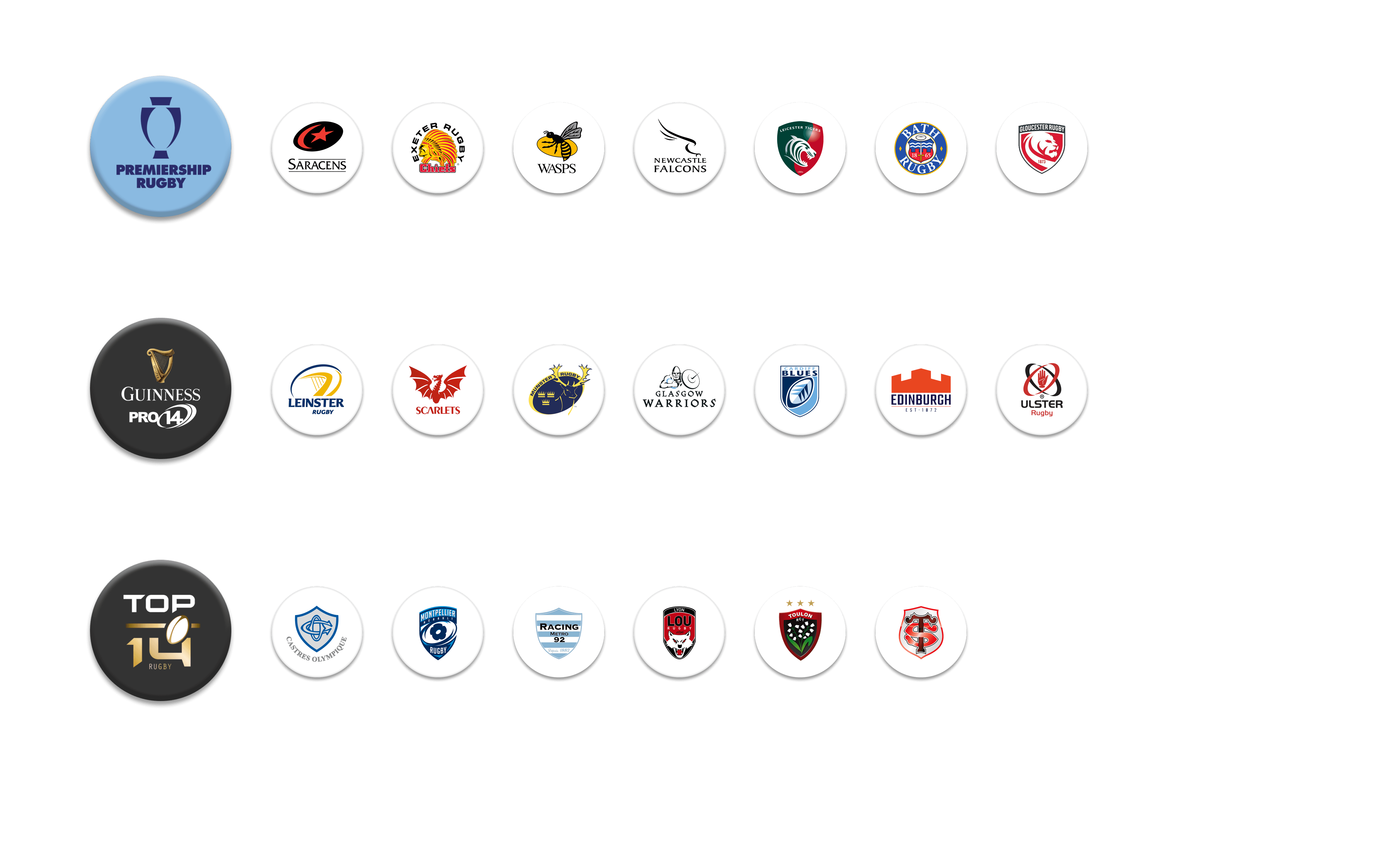

With the changing rugby landscape in the Asia Pacific region and Japan’s growing importance as a rugby playing nation; global management agency Wasserman Rugby has formed an alliance with Hakuhodo DY Sports Marketing (“Hakuhodo”).
The goal of the alliance is for Hakuhodo and Wasserman Rugby to work together to increase the commercial value of rugby players and coaches working in Japan, facilitate new business opportunities for clubs internationally and contribute to Japan’s fast growing rugby culture.
Wasserman Rugby Chairman Peter Kenyon says, “the rugby world in Japan is set for great changes, especially with the newly formatted league planned to start in January of 2022. The transformation is also expected to bring about exciting changes with clubs looking to be diversified and more comprehensive support needed for players and coaches. This partnership will help both organisations achieve their goals and grow their business in Japanese rugby.
Hakuhodo CEO Katsutoshi Iwasa says, “We are very honored to come into an alliance agreement with Wasserman Rugby, who are greatly experienced in the rugby industry. We look forward to contributing together to the growth of rugby both in Japan and around the world by combining our respective expertise and uniqueness to create new values for those involved.”
Wasserman Rugby are specialists in the business of rugby, managing and representing rugby players and coaches around the globe. Not only do they have an extensive client list of rugby clients, but they also hold strong expertise and specialist knowledge of the sport and individuals working within it.
Hakuhodo, headquartered in Tokyo, Japan, provides a full range of sports marketing services. With this alliance, they will expand their athlete management and rugby consultancy operation by adding a player agency arm, helping facilitate the best careers for their clients. Hakuhodo will work in partnership with Wasserman Rugby to create sponsorship deals and other commercial opportunities for both organisation’s clients while also providing on ground support in their respective territories.
For more information contact:
+64 2176 7843
At the end of last month, a few hours after Bristol Bears had announced the stunning signing of Fiji international Semi Radradra on a three-year deal, Pat Lam presided over a bustling press day at Clifton RFC.
Understandably, given news of Saracens’ salary cap scandal and sanctions had broken just a few weeks previously, many questions centred around the financial intricacies of Bristol’s squad.
After all, the Premiership salary cap is currently due to remain at £6.4m for 2020-21, with up to an additional £600,000 dealt to each club for fielding academy players under the age of 24. Unless Lord Myners’ review of the regulations, announced on Thursday, imparts any immediate changes, next season will be the fourth consecutive campaign it has stayed at that mark.
A man of immense integrity, Lam is always generous with his insight. He confirmed that Radradra, who lit up Rugby World Cup 2019, would join from French side Bordeaux Bègles as one of Bristol’s marquee players. Every club can nominate two men whose wages are excluded from that season’s cap.
Lam went further, too. He insisted that he has found the cap “really easy” to negotiate. Then he was almost too honest. In a remarkable soliloquy, Bristol’s director of rugby reeled off no fewer than 22 players that fell into one of two camps. Either Lam had recruited them opportunistically on cut-price offers, or they had been on money that reflected their place on the periphery of the first-team.
They ranged from fly-half Callum Sheedy – “he was sent on loan to Jersey Reds and was third-choice 10 at the club” – to back-rower Luke Hamilton. “I picked him up when he was working in a restaurant in Wales,” said Lam.
In each case, the implication was clear. These individuals were not big-earners, leaving space in the salary cap for fatter contracts. Inadvertently, Lam’s quotes also reinforced a pattern among England’s top-tier squads: the shrinking middle.
Wasserman Rugby Intelligence is the data division of the player management company Wasserman Rugby. According to their research, average Premiership salaries have risen steadily year-on-year since 2017-18, despite the salary cap fix. The cash injection from CVC Capital Partners is just one reason for this. However, the share of individuals commanding a middle-ranking salary of between £70,000 and £140,000 has dropped.
In 2016-17, this bracket accounted for 39 per cent of the league’s players. This season, just 23 per cent earn that amount. Meanwhile, over the same period, the total share of senior players earning between £30,000 and £69,000 per year has risen from 22 per cent to 32 per cent.
Figures from Wasserman Rugby Intelligence
The average age of players within the £70,000-140,000 band has dropped from 27 to 26. There is a heightened emphasis on developing young talent, as a significant hike of upgrades from academy to senior contracts illustrates. Ahead of 2019-20, 71 of these promotions occurred across the Premiership. The previous year saw just 33.
Continuing to use Bristol as an example, Lam mentioned that an impressive academy system, producing starlets such as hooker 20 year-old Will Capon and sparky teenage playmaker Ioan Lloyd, would bring wriggle-room.
Having said that, Mark McCall highlighted the difficulty of re-signing his stellar crop of homegrown Saracens, Owen Farrell and Maro Itoje among them, on the back of the 2017 British and Irish Lions tour. When a core of club players progress to Test level together, things get expensive. Wage demands quickly consume £600,000 of academy credits.
The squeeze on middle-earning squad players, often the honest grafters who need to step up during international periods, is coming from both above and below. Concerns have been raised at players’ board meetings of the Rugby Players’ Association.
“What we recognised last season was more senior Premiership players without a contract, or with their contract values cut, than ever before,” says Rich Bryan, the RPA’s player welfare director.
“We were able to speak to players in pre-season player forums and help them recognise that competition for contracts is probably greater than ever before, so to be prepared for that and for career transitions, whenever they may come.”
Potential solutions will be discussed by the RPA in the New Year, but any radical expansion of the salary cap – which Bryan stresses is crucial for “stability, sustainability, job security within the game” – will not be desirable.
“We have to keep tracking it,” Bryan adds. “Are these market forces? Is this the way the game is going? Does it need to be addressed? Can it be addressed?
“Is there more emphasis on academy players coming through? The squeeze in the middle is something we have seen and we will be continuing to monitor.”
Wasserman Rugby Intelligence crunch numbers to determine salary bands per position, with an ‘A’ label outlining what a first-choice player would be expected to earn, ‘B’ a second-choice player and so on. Interestingly, there were just 30 new signings in the Premiership B and C bands for 2019-20, fewer than the 36 additions in the same area in 2018-19.
Conversely, the Pro 14 had an increase from 11 to 21 signings in the same two bands. Wasserman Rugby analysts believe this is partly down to compensating for Rugby World Cup losses, which are on the whole more drastic for Pro 14 sides. Yet the figures suggest more claustrophobia for the Premiership’s middle.
Ultimately, a canny coaching set-up will trust its on-field methods to polish rough diamonds. But that must go hand-in-hand with sufficiently strong leadership to protect dressing room unity from jealousy and animosity.
“I don’t like to pay on potential or whatever,” explained Lam this week, elaborating on his penchant for underdogs. “It’s about what people have done. If you create a culture like that, you are asking people to work hard. Then they will get rewarded.
“You are looking for people who are motivated, who have dreams and are going to come through. If you get dropped or don’t get a contract, it’s only one person’s opinion. All the best stories in life about successful people are about what they had to do when they were down to come back up.
“Those are the kind of people you are looking for because they are the fighters who won’t quit. Then, if they’re coachable, you will get a bit of magic.”
Clearly, such moments of magic can help players enhance their value. But climbing the wage structure towards a shrinking middle must be a daunting experience.
By Josh Crane
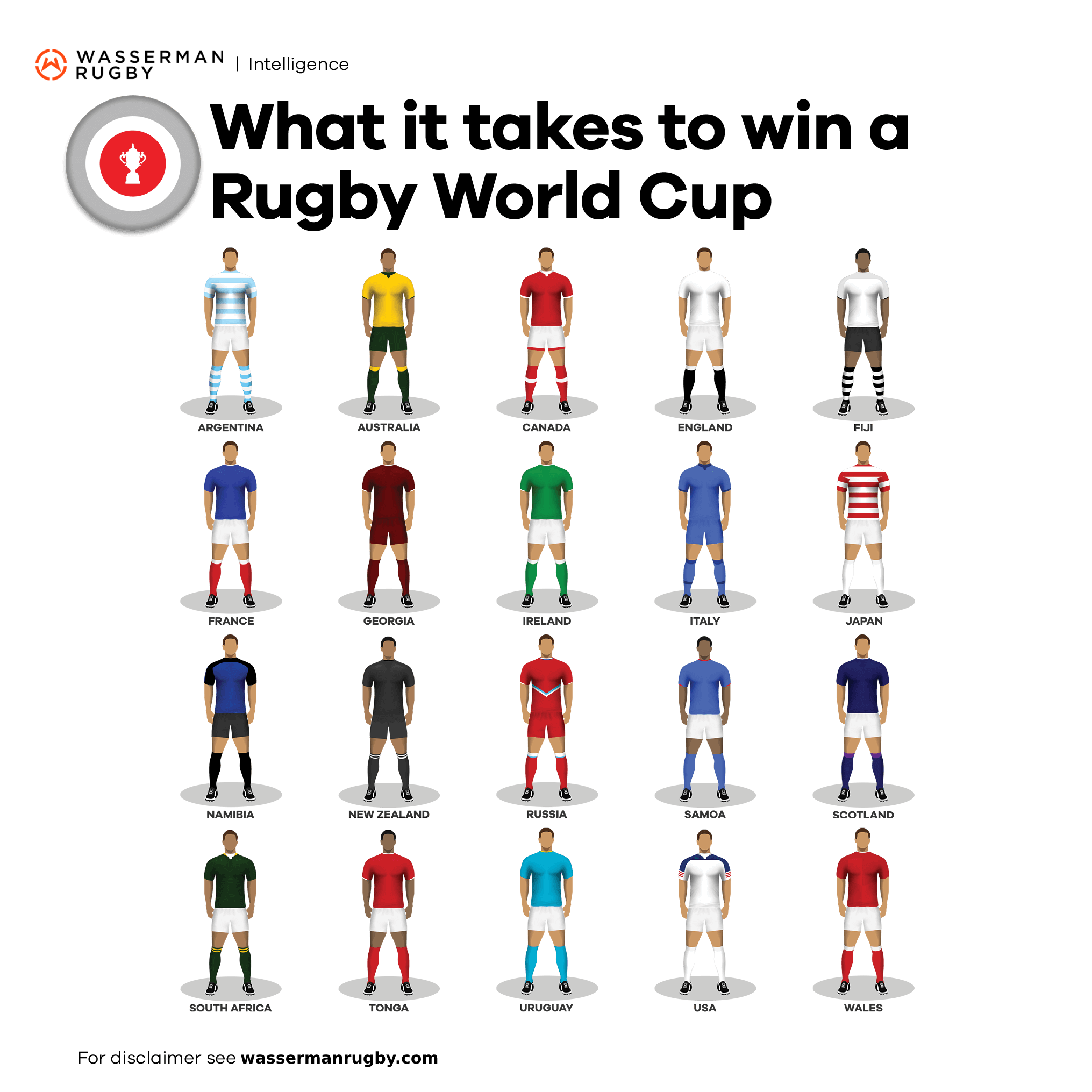
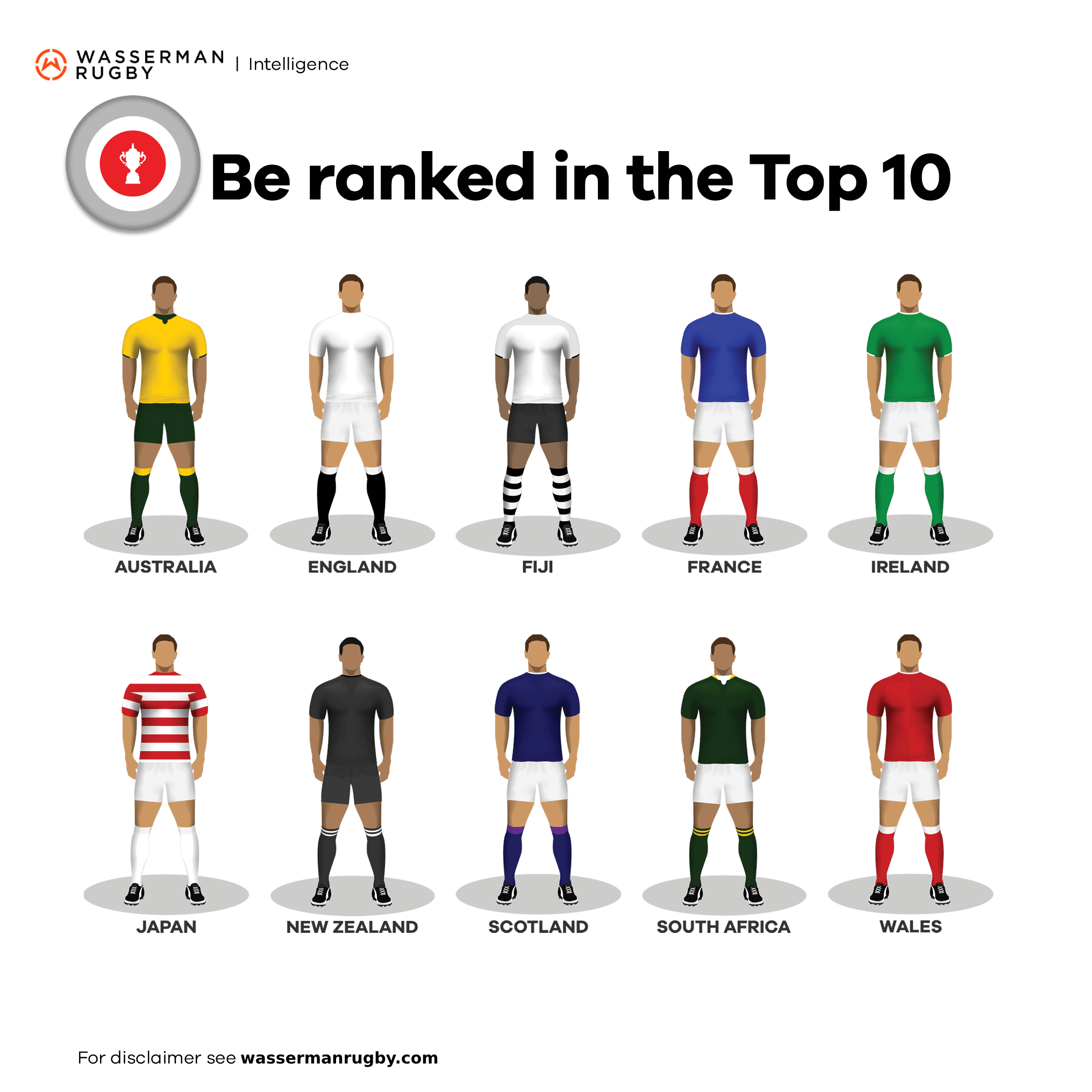
One thing that is proven to have substantial influence in a Rugby World Cup is international experience. When looking at winning match-day squads from 1999 onwards (before this, fewer matches generally and players mixing work with rugby in the amateur era do not provide a fair comparison), they all have caps in abundance with, on average, over 850 caps; the pinnacle being New Zealand in 2015 who amassed 1225 caps amongst the match-day 23. None of the remaining match-day 23s* from this year reach these heights, but New Zealand do top the pile again amassing 1093 caps between them, followed by Ireland with 1026 caps and then Australia with 966.
However, 4 teams don’t make the grade – Japan (481), Fiji (503), France (721) and Scotland (760), which cuts our 10 down to 6.
*Match-day 23s based on players selected to Rugby World Cup squads and are predicted to make up the first-choice team.

It is shown in most sports that players perform best when they are in their prime years and this is no different for rugby. A player’s prime years in rugby are seen to be between 27 and 29, where the player is still seen to be in peak physical condition as well as having gained substantial experience. Rugby World Cup winning sides of the past highlight this with (a) 5 of the 8 having the majority of their squad in this category and (b) all 8 having a combined average of 30% of their final Match day squads in this category.
Unfortunately for Ireland this crosses them off the list, having only 4 players in this age range (only 17% of their match-day 23). If this same question had been asked a year ago, they had double this amount which may be one reason behind their drop-off in performances from 2018 to 2019.

Defence is key for any team to not lose a game, but you can only win games by attack and getting points on the board. This is likely to be the case in Japan with the hot weather conditions and dry pitches providing a platform for attacking rugby. Previous winners show the importance of having a good attack by not only scoring lots of points vs Tier 2 nations but also having a good enough attack to terrorise even a Tier 1 defence, which is crucial in the latter stages of the competition. Previous winners of the competition have averaged just under 30 points per game against Tier 1 nations in their winning campaigns with New Zealand averaging over 40 points per game in 1987. This doesn’t bode well for Wales who have only scored more than 20 points once against Tier 1 nations in their last 5 games (average of 17 points) and having not scored more than 30 points against one since June 2018.
Australia scrape through this round averaging 25 points per game in their last 5 games against Tier 1s, but if you remove the exceptional New Zealand side from 1987, this fits in with the average which slips to just a point above.
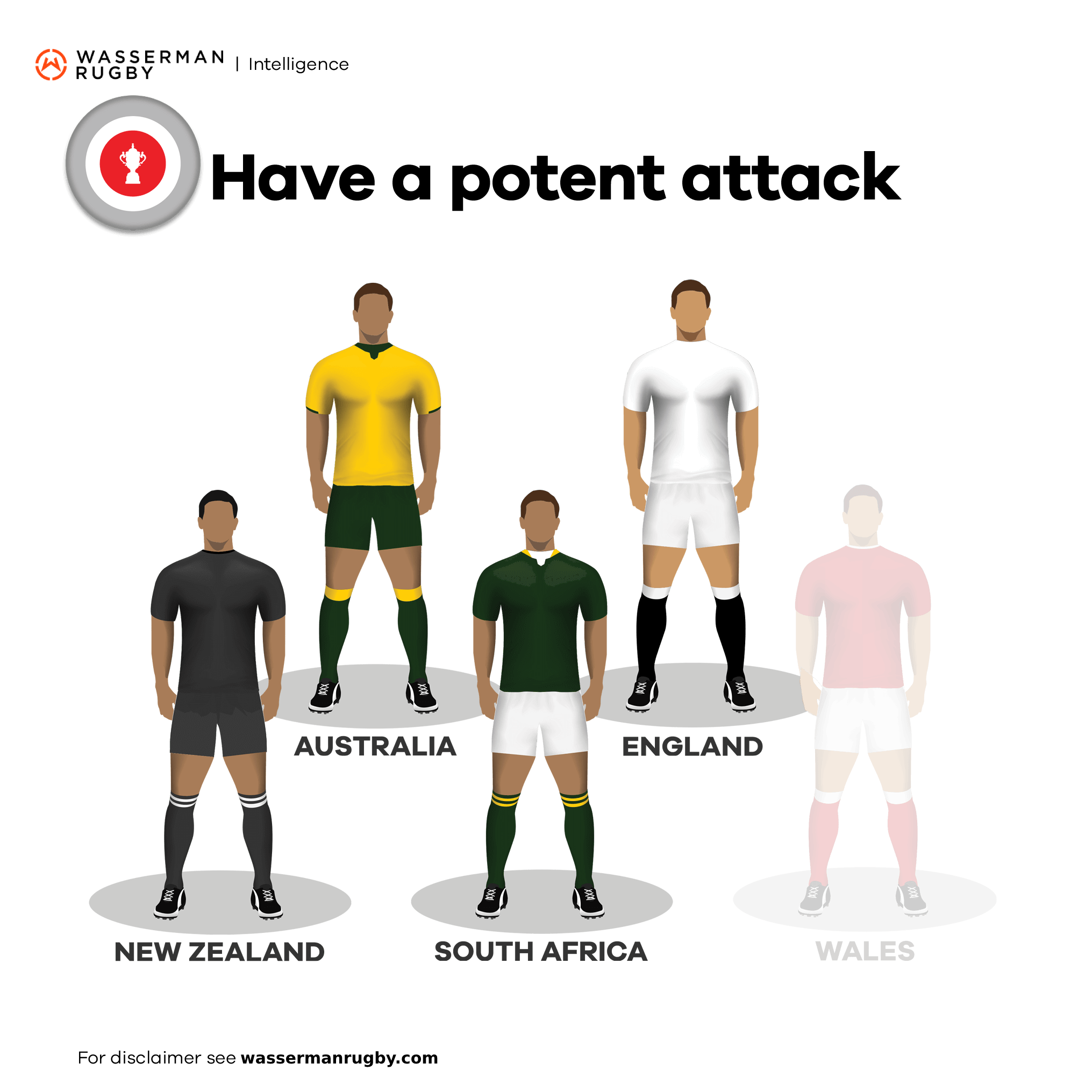
Even though rugby is a team sport, in important games it often does take one player to lead their team home – often done by one of the world’s best. This is highlighted by the winning team of every historical RWC having had at least 1 player nominated for the ‘Player of the Year’ award in the year leading up to it. Furthermore, all bar one team had the Player of the Year for the Rugby World Cup year also (when New Zealand won in 2011, Thierry Dusautoir (France) won Player of the Year).
This cuts our short list in half with only New Zealand and South Africa, out of the remaining teams, having players nominated last year (2 each, De Klerk and Marx for South Africa; Barrett and Ioane for New Zealand).

Now we have narrowed it down to 2 teams it really does take something quite trivial to separate them. The fact is that no team has won the Rugby Championship (Tri Nations previously) and Rugby World Cup in the same year since they both first coincided in 1999… it is almost as if New Zealand planned it winning it in the last 3 years. Further to this, only Australia (in 2015) reached a World Cup final after winning the Rugby Championship, which no team had done before.
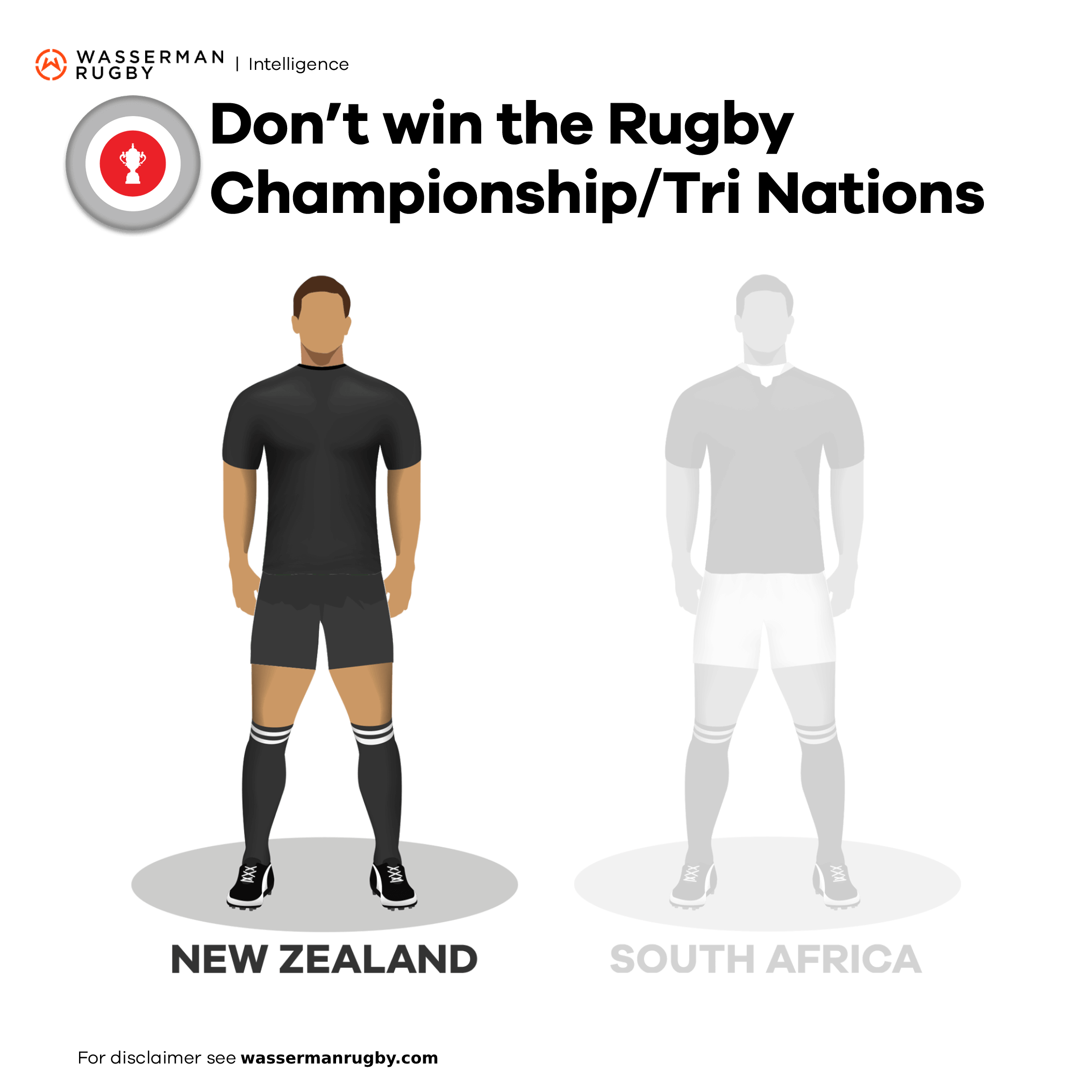
There were no changes to Head Coaches from 2018, with most coaches having been contracted until post-World Cup 2019. So, it’s the last Six Nations for Warren Gatland, Joe Schmidt and Jacques Brunel, as well as it being heavily rumoured that Eddie Jones will also follow suit. In terms of international experience, Warren Gatland stands apart from the others with 16 years’ experience (the closest being Eddie Jones with 13 years).
Despite Jacques Brunel having over 30 years coaching experience including 6 years as an assistant coach of France, Brunel only has 8 years’ experience as Head Coach (including a spell with Italy). This is then closely followed by Schimdt with 7 years’ experience. The two stragglers in this regard are Conor O’Shea with 4 years’ experience and Gregor Townsend with 3 years but the latter has a growing reputation since his transition from player to coach and both boast successful CVs from the club game.
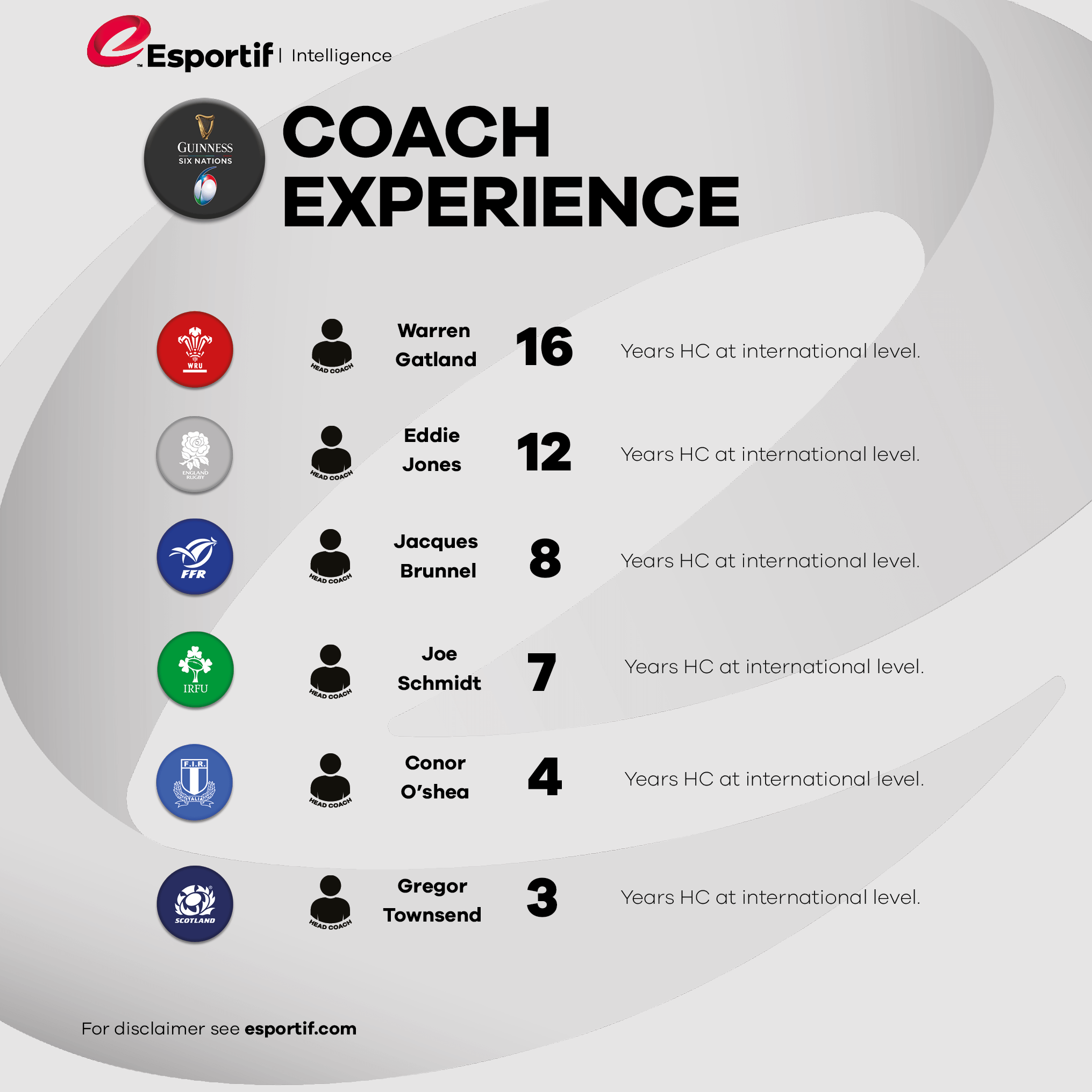
In terms of caps, Ireland have by far the most with a total of 866 – an increase of 47 from last year’s total. With a very similar squad to the opening game last year, Schmidt has a core group of players that he has been using for more than just this year despite having capped 46 players since last year’s Six Nations. Only 4 of the 23 have less than 10 caps and only 1 player has less than 5 (Cooney).
After experimenting with the most inexperienced squad last year (262 caps among the 23), the return of the old guard of Parra, Fofana, Huget and Medard (with over 200 caps between them) saw France on par with the other nations at the start of their campaign. Wales and Scotland have both been impacted by injuries to key players in the last 2 years of the Six Nations, albeit oppositely. For Wales, the return of key players this year (Tipuric and Davies) sees them 2nd highest in terms of test match experience, correlating with their performances and eventual Grand Slam. However, for Scotland, injuries to Barclay and Watson (with 94 caps between them) may help to explain their tepid campaign culminating in a Twickenham classic.
Another team to concede experience was England, with Jones losing faith in a number of stalwarts from when he first took over (Hartley, Cole and Robshaw). But the opposite happened for England who started the campaign in blockbuster fashion before a 2nd half collapse against Scotland in the final game, arguably exposing their lack of experience.
Italy started the 2019 Six Nations with one of the most experienced packs in the competition, mainly down to their beloved captain Parisse and the ever dependable Ghiraldini (who between them have 72% of the total caps of their starting pack and make up 42% of the whole 23’s caps). Without them, however, they remain one of the most inexperienced teams despite an increase in caps across the back line this year.

Age is a very interesting area to look at in terms of this year’s Six Nations. Teams that did well this year saw a large part of their squad falling in the 27-29 age category which is generally considered to be prime age for rugby players (peak of physicality as well as playing with experience). This was the case for the teams finishing 1st and 2nd (Wales and England), both boasting high numbers in this age category. Both teams were also bolstered by large numbers in the age category below (24-26) with 6 Welsh and 3 English players entering their 27th year next year (also boding well for future campaigns). The one factor which separates these teams in terms of age, and may have been a determining factor in the race for the Six Nations, is England only had one player in the 30+ category whereas Wales had 4. This experience shone through in their game against England.
Ireland on the other hand have the greatest share of their 23 in the 30+ category (8 players), 5 of which are in the Starting 15. This potentially raises some questions as to whether the Ireland squad are now moving out of their prime years and may explain the drop in performances from last year (when they had 8 players in the prime years). The 24-26 age category dominates for both Scotland and Italy but, albeit the latter have no players below this age range (understandably relying on experience this close to a World Cup). Scotland have the fewest players in the top two age categories similar to last year. With these age ranges proving pivotal for Wales and England, was this a factor in Scotland’s disappointing 2nd last finish?
France have the widest age range across their squad, including 2 below 20yrs of age and 6 30+ (including the return of some of the experienced players noted above).
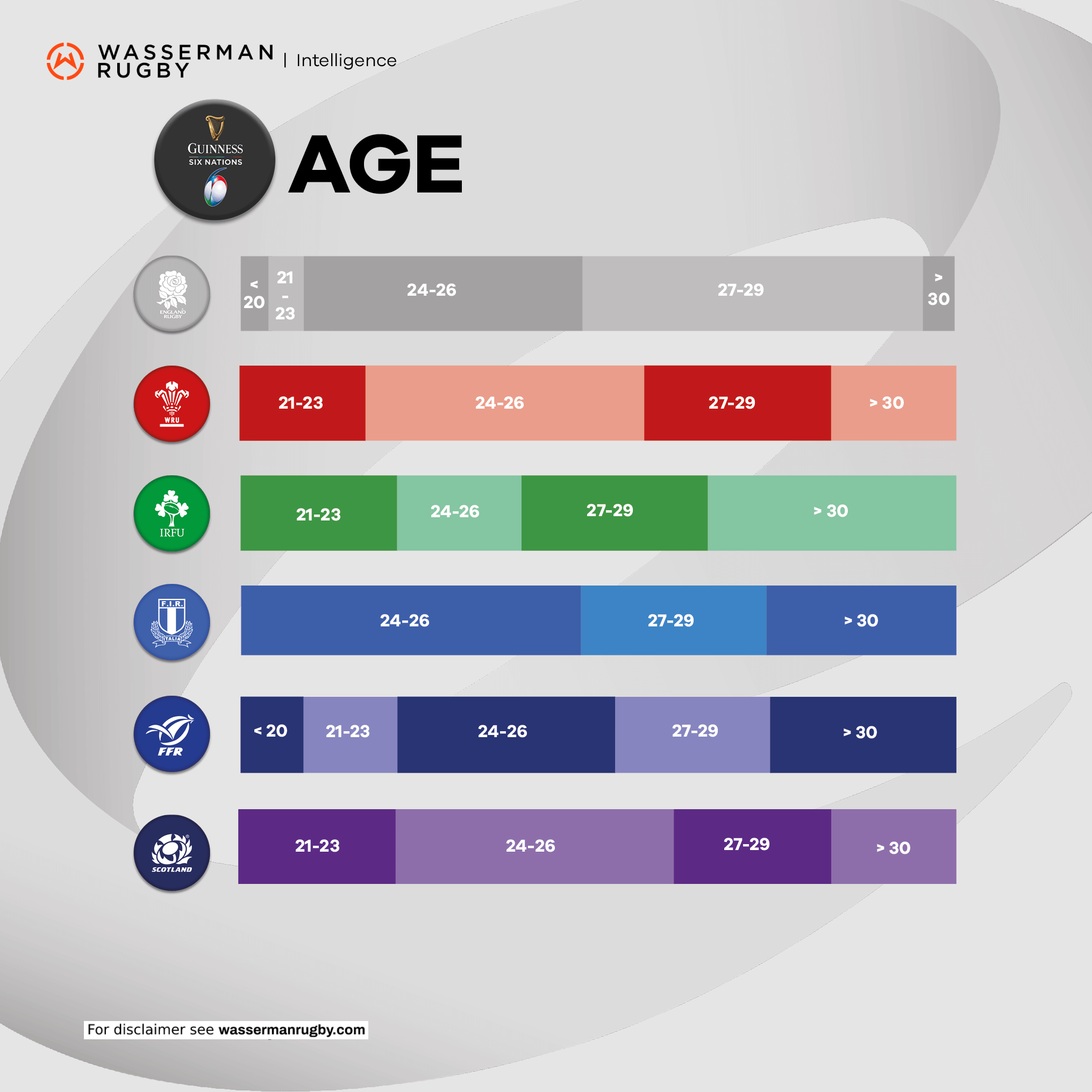
Breakdown of the players by club is an area where England and France are often seen to have a big disadvantage because of the sheer volume of top-level clubs in their home nations. Both 23s are spread across 8 and 10 teams respectively with a max of 6 players from one club, making team cohesiveness more challenging. This compared to Ireland whose 23 are spread across 4 teams and, with 56% of players coming from Leinster (and potentially more from their development system), provides a drastic contrast.
Though both Wales and Scotland’s teams draw from a similar number of clubs as England and France, the key difference is that both have over 35% of players from the same club. Furthermore, the majority of their 23s play their club rugby in Wales (19 across 4 clubs) and Scotland (16 across 2 clubs) respectively.
Notably, both these teams ought to be careful as these numbers dropped from 2018 but, with Wales implementing a new contracting system, it is expected to help keep top international talent in Wales. The opposite may be true for Scotland as, following a number of key players already leaving in previous seasons (Laidlaw and Russell), Hogg is set to follow post-World Cup. Italy are another team with the majority of the 23 playing in Italy (20) and predominantly with Benetton; however, with no restrictions on international selection, could we start to see the same vacuum form around Italy’s top talent?
In terms of the final standings, the aforementioned experience of not only Gatland but also Wales’ key players (both in terms of caps and the 30+ category) appeared to prove invaluable. This, backed up by the age profile of their squad, bodes well for the upcoming Rugby World Cup (where, historically, winning teams since [1999] have averaged over 878 caps).

From Joe Schmidt to Vern Cotter, Dave Rennie and Pat Lam, New Zealand coaches continue to command many of the world’s highest paid positions. Over the next few years, though, the cycle of those leaving for European posts may take a downward turn.
When it comes to the transfer market, players are so often the focus. Every week, it seems, another All Black is linked to or takes up another lucrative offshore deal.
Yet in many respects, coaches are more influential in driving cultural and cohesion changes. Get the right, or wrong, mentor and fortunes quickly turn.
Increasingly this realisation is being made. And more often than not, New Zealanders are sought after to take the lead.
The stats don’t lie. Seven of the 20 head coaches at this year’s World Cup will be New Zealanders. Nine more are at the helm across Europe’s major leagues — France’s Top 14, England’s Premiership and the Pro14. Eight others — two in Australia — hold the reins in Super Rugby.
Cotter heads the list of domestic top earners on what is believed to be close to €1 million per season ($1.6 million) at Montpellier.
Rennie, with Glasgow, and Lam, at Bristol, are understood to be the highest paid coaches in their respective competitions.
Specialising exclusively in the management of leading coaches, Wasserman Rugby director Duncan Sandlant is well placed to view the changing landscape.
“There is definitely greater recognition of professional rugby coaches and the difference a quality head coach or assistant can make in terms of performance in an increasingly competitive market, particularly in light of salary cap pressures which don’t apply to coaching spend,” Sandlant says.
“Like the player market, the coaching market has become increasingly more global and competitive. There are still clubs that believe in the ex-star player being the best way forward as a head coach, which was and still is prevalent in football, but you only have to look at clubs or national rugby unions that have invested in quality professional coaching teams to see the benefits.”
This premium demand for Kiwi nous has been created by a track record of success.
Warren Gatland’s coaching career took off with three titles at Wasps. Cotter built Clermont into the club they are today. Lam, after being binned by the Blues, achieved what no one thought possible with Connacht. Wayne Pivac, having never made the Super Rugby grade, transformed the Scarlets into Pro14 champions and is now poised to succeed Gatland with Wales next year. Schmidt — another Blues castoff — led the Leinster and Irish golden age.
Such success in all major European rugby nations places Kiwi coaches at the head of the recruitment queue. No other foreign nation has made a comparable mark.
Former Wallabies playmaker Pat Howard enjoyed success at Leicester but few other Australians have made an impact.
Likewise, South Africans. Springboks coach Rassie Erasmus left an impression at Munster but he was there only 18 months and his squad were inspired to play for Anthony Foley following the sudden death of the much-liked assistant coach in Paris.
Elsewhere, Jake White has been underwhelming, while former Lions coach Johan Ackermann is doing a reasonable job with Gloucester.
New Zealand has always recognised the importance of quality coaching.
Sure, the talent base and inherent attacking skills are driving factors but coaching is a major reason why the All Blacks have, to this point at least, enjoyed a consistent edge on the rest of the world.
Like players, though, New Zealand will never be able to compete on coaching salaries.
In recent times, New Zealand has lost Rennie, Lam, Chris Boyd, Todd Blackadder, Jamie Joseph and Tony Brown — all from Super Rugby to big-money contracts. That’s a lot of intellectual property.
Three years ago, the gap in earnings was greater than it is now. New Zealand Rugby has made an effort to pay their coaches more and also recruited foreigners in the form of men’s sevens coach, Scotsman Clark Laidlaw, and Crusaders assistant Ronan O’Gara.
Yet with the average head coach in Europe pocketing around £250,000 ($471,000), the global value will always be out of reach.
Brown, with Japan, is thought to be one of the highest paid back attack coaches in world rugby, on around $500,000 for his dual roles with the national team and the Sunwolves.
Compare that with New Zealand, and Highlanders head coach Aaron Mauger earns around half that figure.
Money is not everything, of course.
New Zealand’s strength lies in its commitment to development which, therefore, comes with security not afforded in Europe. Even those who clearly struggle, the likes of Sir John Kirwan and Tana Umaga at the Blues, were given at least three years to imprint their vision.
Overseas, the coaching profession is fraught from day one. During the past two years, 22 of the 40 head coaches in the Premiership, Pro14 and Top 14 have changed, with four more already known for next season.
Geordan Murphy is the fourth head coach at Leicester Tigers in 21 months.
Sandlant, a qualified lawyer and recently voted among Rugby World’s top 50 list of influential people in the game, witnesses these knee-jerk reactions all too often.
“It is really important that coaches are protected as much as possible from a contractual point of view at the outset, as you have unrealistic owners or boards where reality and expectation are not aligned.
It is very common for owners, CEOs and executive board members, some of whom have limited knowledge of professional sport, making decisions on their head coach based on incorrect information, facts or fans’ views on social media.
The consequences for these coaches can be pretty extreme, with a number not being employed again and, unlike football, they don’t get life-changing golden handshakes on the way out. It is an incredibly high risk career, with a number of factors completely outside a coaches’ control.”
Assessing New Zealand’s Super Rugby landscape, it is difficult to envision many jumping into the European guillotine in the coming years.
Highlanders duo Mauger and Mark Hammett, the latter at the Cardiff Blues, have been burned before and are unlikely to return any time soon. John Plumtree’s Hurricanes tenure is beginning as he settles into his home town franchise.
Leon MacDonald is the latest to begin the task of turning around the Blues, and he is joined by Tom Coventry, who did not have the roster or support to stop London Irish being relegated.
Tabai Matson, having returned from a brief stint at Bath alongside Blackadder, probably has visions of succeeding Colin Cooper with the Chiefs.
Scott Robertson is the exception. Should he miss out on promotion to the All Blacks next year, Robertson may seek a position in France, though leading the Crusaders is a prime role and one hard to walk away from.
International opportunities will arise post-World Cup but, even then, most major nations have succession plans in place.
Risk and reward must be weighed in every instance, as one wrong move can end a career.
Of the 59 head coaches across top competitions, excluding Japan, 18 are New Zealanders.
World Cup teams: Twenty head coaches, seven New Zealanders — Milton Haig (Georgia), Joe Schmidt (Ireland), Steve Hansen (New Zealand), Steve Jackson (Samoa), Jamie Joseph (Japan), Warren Gatland (Wales), John McKee (Fiji).
Pro14 (14 HC): Three New Zealanders — Kieran Crowley, Dave Rennie, Wayne Pivac. Brad Mooar will be the latest recruit, when Pivac steps up to Wales next year.
Premiership (16 HC/DOR): Three New Zealanders — Todd Blackadder, Pat Lam, Chris Boyd.
Top 14 (15 HC): Three New Zealanders — Vern Cotter, Jono Gibbes, Simon Mannix.
Super Rugby (15 HC): Eight New Zealanders — Leon MacDonald, Colin Cooper, Scott Robertson, Aaron Mauger, John Plumtree, Brad Thorn, Tony Brown, Daryl Gibson.
New data has been released by a major players’ agency
BY JON DOEL (WALES ONLINE, 2 JAN 2019)
The data released by top player agency Wasserman Rugby Intelligence shows outside-halves get paid more than any other positions in the PRO14, Gallagher Premiership and Top 14.
Wales star Dan Biggar is one of those, reportedly taking home around £600,000 a year at Northampton Saints. He is thought to be among the top 10 earning rugby players in the world right now. You can see the full list here.
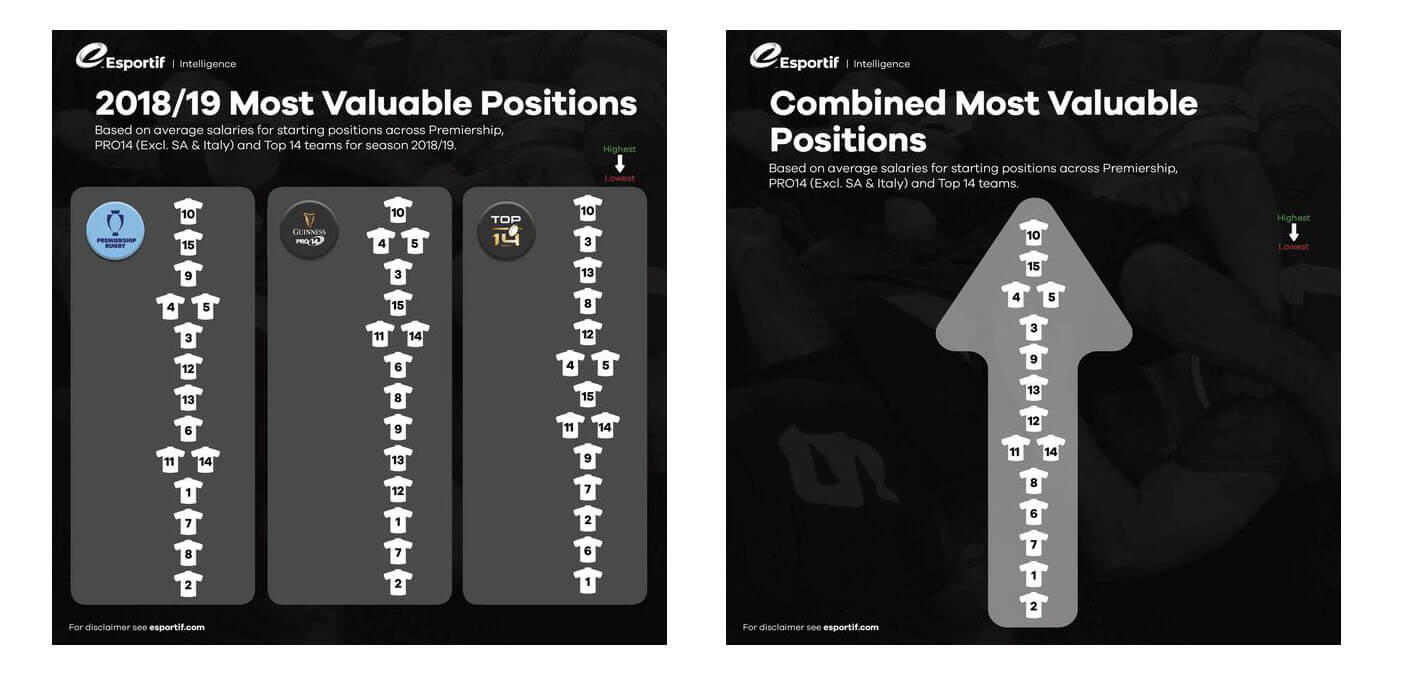
There are intriguing differences in the next best paid positions in Europe’s top three leagues, with second rows perhaps surprisingly raking in more than other positions in the PRO14, while full-backs are second in line in the English Premiership and tighthead props are the second best paid in France, according to the average salary data.
Goal-kicking expertise and occupying a position of weakness in certain leagues all count towards boosting a player’s value, with tight heads seen as vital in the forward-orientated Top 14. Number threes also figure highly in the PRO14 and Premiership, with the specialist nature of the position and the relative lack of top players who can play there being key.
Bristol’s former All Black full-back Charles Piutau is reportedly the highest paid player in Europe in £1m a year, which may well account for the rise in average pay for full-backs in England’s top division.
Hookers are the worst paid players on average in the PRO14 and England, while open side flankers also figure relatively lowly in all three leagues.
PRO14 wingers were actually paid the least when similar figures were released a year ago, but the men out wide have seen a jump in the past year, occupying fifth spot on the list.
Average wages are higher in England and France, with the help of wealthy benefactors and bigger TV deals meaning there are more foreign imports.
The average squad in France is 44% foreign imports, compared to 38% in England and 28% in the PRO14.
Alun Wyn Jones’ incredible 2019 Championship Alun Wyn Jones: Leader, legend, lock of a lifetime VIDEO: Alun Wyn Jones’ best bits from the 2019 Championship
Jones captained his side to victory, beating out all opposition in this year’s Championship and securing Wales’s first Grand Slam since 2012.
Wales’s 2019 Guinness Six Nations commenced with a resolute comeback win versus France in the Championship opener in Paris before they continued with a series of dominant performances throughout the Championship.
Victories followed against Italy, England and Scotland, and finally against the title holders Ireland at Principality Stadium to cap off an impressive Grand Slam Championship.
Jones said: “I’m very flattered to be named the Guinness Six Nations Player of the Championship. For me as the captain, it’s a validation of what we’ve done as a squad throughout the campaign.
“To be up there as a nominee with three other Welsh players and two outstanding players from England would have been more than enough and I’m very grateful to the people who have taken the time to vote.”
Jones becomes the fifth Welsh player to win the award following fellow forwards Martyn Williams and Dan Lydiate, plus wing Shane Williams and full-back Leigh Halfpenny.
He is also the fourth forward to win the award, following Williams, Lydiate and Ireland’s Paul O’Connell.
Ahead of going to a public vote, a shortlist of six potential players of the Championship, four Welsh and two English, were chosen by an expert panel of distinguished rugby writers and broadcasters from across the six participating countries:
Earlier this year Energia became the ‘Official Energy Partner of Leinster Rugby’, proudly committing to a 10-year sponsorship deal that includes the naming rights for Energia Park. The long-term agreement allows Energia to deliver its vision through their new campaign #ThePowerBehindLeinster, powering rugby from grassroots through to the European stage, with 21-year-old Larmour taking centre stage.
Larmour rose through the ranks of the Leinster Schools Programme and has cherished memories of playing in Energia Park for his former school St Andrew’s College. Upon finishing school, the flier was immediately scouted for the Leinster Academy before making his senior debut. Now with over 25 caps for his club, and nine for Ireland, there’s no doubt Larmour’s career is bright.
Speaking at the announcement, Larmour commented: “I am delighted to be coming on board as an ambassador for Energia. We’re both beginning our respective journeys with Leinster Rugby and have set big goals. I am really looking forward to collaborating with them over the coming years as they continue to support rugby in Ireland.”
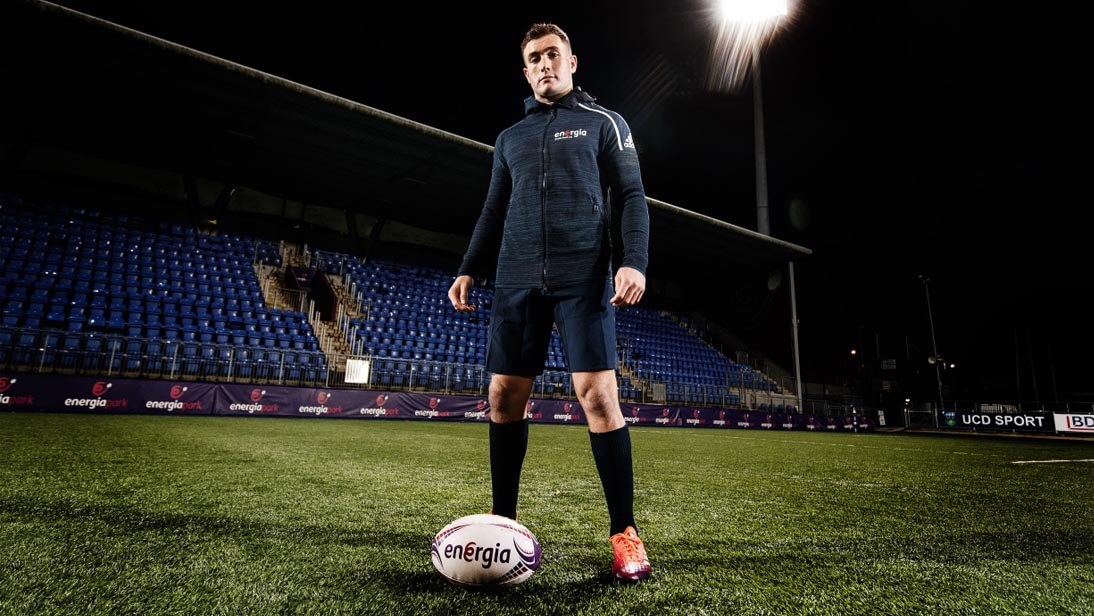

(Wales Online – 2nd January 2019)
The best paid positions in European rugby’s top leagues this season have been revealed.
The data released by top player agency Wasserman Rugby shows outside-halves get paid more than any other positions in the PRO14, Gallagher Premiership and Top 14.
Wales star Dan Biggar is one of those, reportedly taking home around £600,000 a year at Northampton Saints. He is thought to be among the top 10 earning rugby players in the world right now. You can see the full list here.
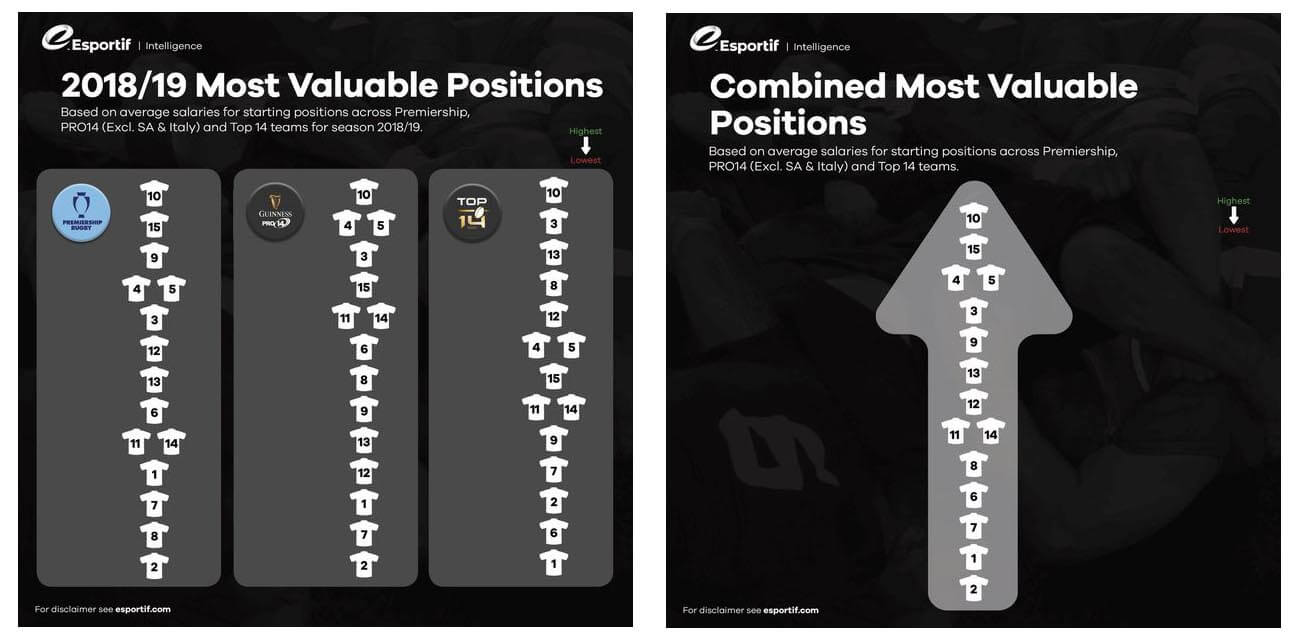
There are intriguing differences in the next best paid positions in Europe’s top three leagues, with second rows perhaps surprisingly raking in more than other positions in the PRO14, while full-backs are second in line in the English Premiership and tighthead props are the second best paid in France, according to the average salary data.
Goal-kicking expertise and occupying a position of weakness in certain leagues all count towards boosting a player’s value, with tightheads seen as vital in the forward-orientated Top 14. Number threes also figure highly in the PRO14 and Premiership, with the specialist nature of the position and the relative lack of top players who can play there being key.
Bristol’s former All Black full-back Charles Piutau is reportedly the highest paid player in Europe in £1m a year, which may well account for the rise in average pay for full-backs in England’s top division.
Hookers are the worst paid players on average in the PRO14 and England, while openside flankers also figure relatively lowly in all three leagues.
PRO14 wingers were actually paid the least when similar figures were released a year ago, but the men out wide have seen a jump in the past year, occupying fifth spot on the list.
Average wages are higher in England and France, with the help of wealthy benefactors and bigger TV deals meaning there are more foreign imports.
The average squad in France is 44% foreign imports, compared to 38% in England and 28% in the PRO14.
Here we compare and contrast some key attributes of Premiership, PRO14 and Top 14 squads in the 2018-2019 Heineken Champions Cup.
The first obvious variation is age with both Premiership and PRO14 clubs having roughly the same average squad ages (26.7 and 26.2), while the Top 14 clubs, in comparison, have a much higher average squad age. That is, a full 2 years more experienced than PRO14 clubs on average.
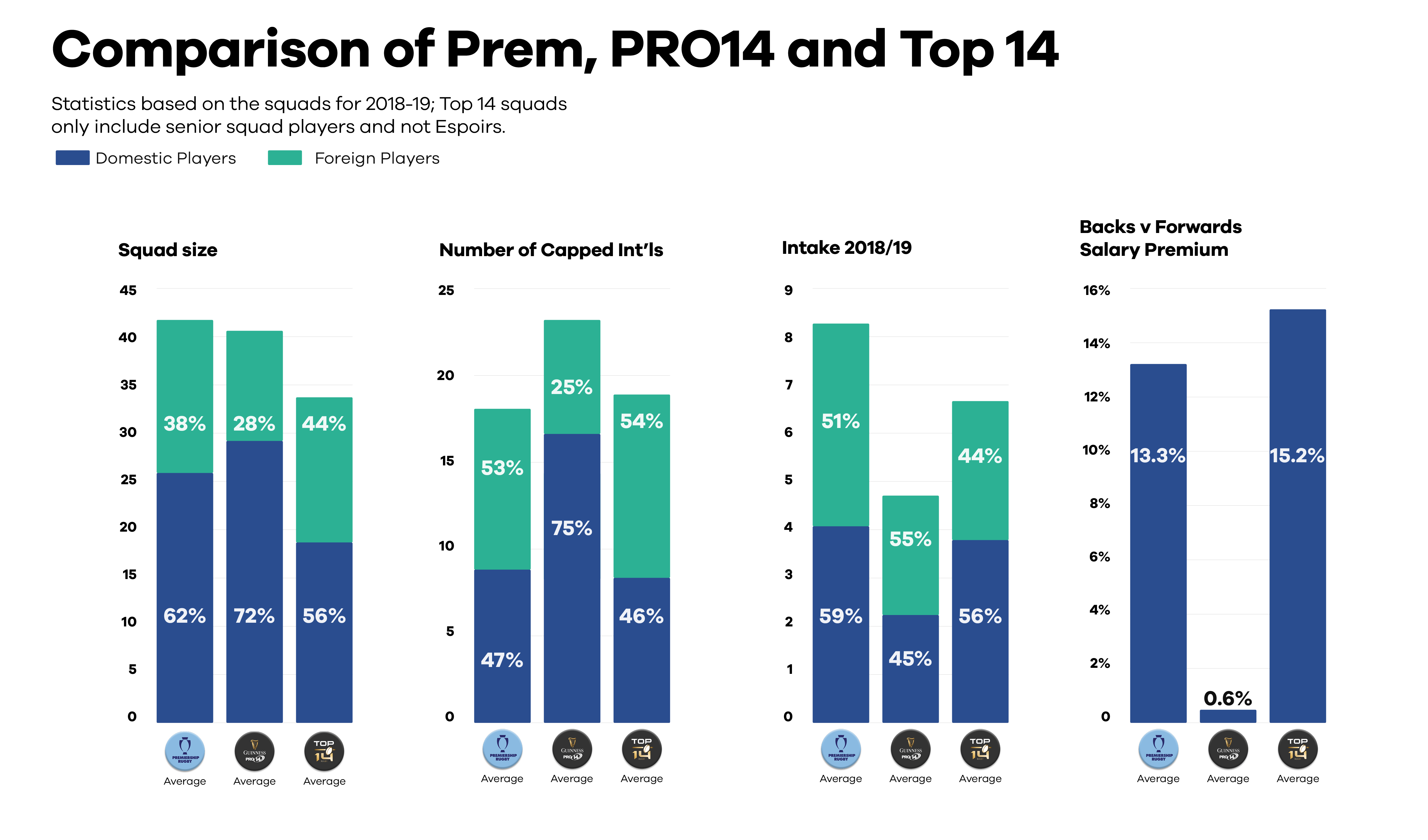 Squad size is another variation we see when comparing leagues with both Premiership and PRO14 teams averaging squad size above 40, whereas Top 14 teams (excluding Espoirs) are limited to 35 senior contracts per side. Furthermore, the percentage of these which are domestic players is just over half (56%), where in contrast 62% of the Premiership squads are domestic and 72% of the PRO14’s. Top 14 teams also spend 52% of their budget on foreigners (compared with 44% of their squad by numbers) with the average foreign player salary premium being nearly 30% higher than domestic players. This again differs to the PRO14 and Premiership who spend the higher percentage of their budgets on domestic players (67% and 56% respectively). But these two leagues on average do also pay a premium for foreign players of 22% in the Premiership and 19% in PRO14 compared to domestic players.
Squad size is another variation we see when comparing leagues with both Premiership and PRO14 teams averaging squad size above 40, whereas Top 14 teams (excluding Espoirs) are limited to 35 senior contracts per side. Furthermore, the percentage of these which are domestic players is just over half (56%), where in contrast 62% of the Premiership squads are domestic and 72% of the PRO14’s. Top 14 teams also spend 52% of their budget on foreigners (compared with 44% of their squad by numbers) with the average foreign player salary premium being nearly 30% higher than domestic players. This again differs to the PRO14 and Premiership who spend the higher percentage of their budgets on domestic players (67% and 56% respectively). But these two leagues on average do also pay a premium for foreign players of 22% in the Premiership and 19% in PRO14 compared to domestic players.
The average PRO14 intake in 2018-2019 saw a higher percentage of foreign players coming in compared to domestic players, whereas the Premiership and Top 14 both recruited a higher percentage of domestic players as well as more new recruits in total. Premiership teams brought in 8.4 players on average, Top 14 6.8 players whereas the PRO14 squads remained more settled with only 4.7 additions on average.
Another squad attribute we explored is the number of capped internationals – on average, each PRO14 club has almost 23 capped internationals in their squad. This, in comparison to 18 capped internationals in the Top 14 and Premiership, is substantial. However, putting this into context of squad size, the Top 14 and PRO14 have the same percentage of their squads capped (55%) while this falls to 43% in Premiership squads. Yet, upon a closer look, only 35% of Top 14 squads are current internationals and only 25% of Premiership squads (PRO14 has the highest percentage at 42%). The significant drop in the Top 14 could be put down to a number of ex-internationals going to play in the Top 14, aligning with the average age of foreign capped internationals being just under 30.
Considering these capped internationals further, a higher percentage are capped by foreign nations than are capped by the domestic nation in both the Premiership and Top 14 (53% and 54% respectively) whereas, in the PRO14, 75% of their internationals are domestic. A significant contributing factor to this differential is the number of teams in the Premiership and Top 14 (each posting talent from one country only) compared to fewer teams in each of Ireland, Wales & Scotland together making up the PRO14 (with Italy & South Africa). With both the unions of Ireland and Wales also placing restrictions on their internationals playing abroad and Scotland’s centralised control, it’s no surprise that the top teams have high percentages of domestic internationals.
The final interesting variation in squad make-up based on this analysis is the premium that clubs in each competition pay on backs compared to forwards. On average, the amount paid to backs and forwards in the PRO14 is essentially the same with only a 0.6% premium (for backs). In contrast, the Premiership clubs pay their backs 13.3% more on average and the Top 14 pay their backs 15.2% more on average. As well as this, backs that were recruited in the Top 14 in 2018-2019 came at a 34% premium compared to the forwards that were recruited, dropping to 17% for the PRO14 and 12% for the Premiership.
